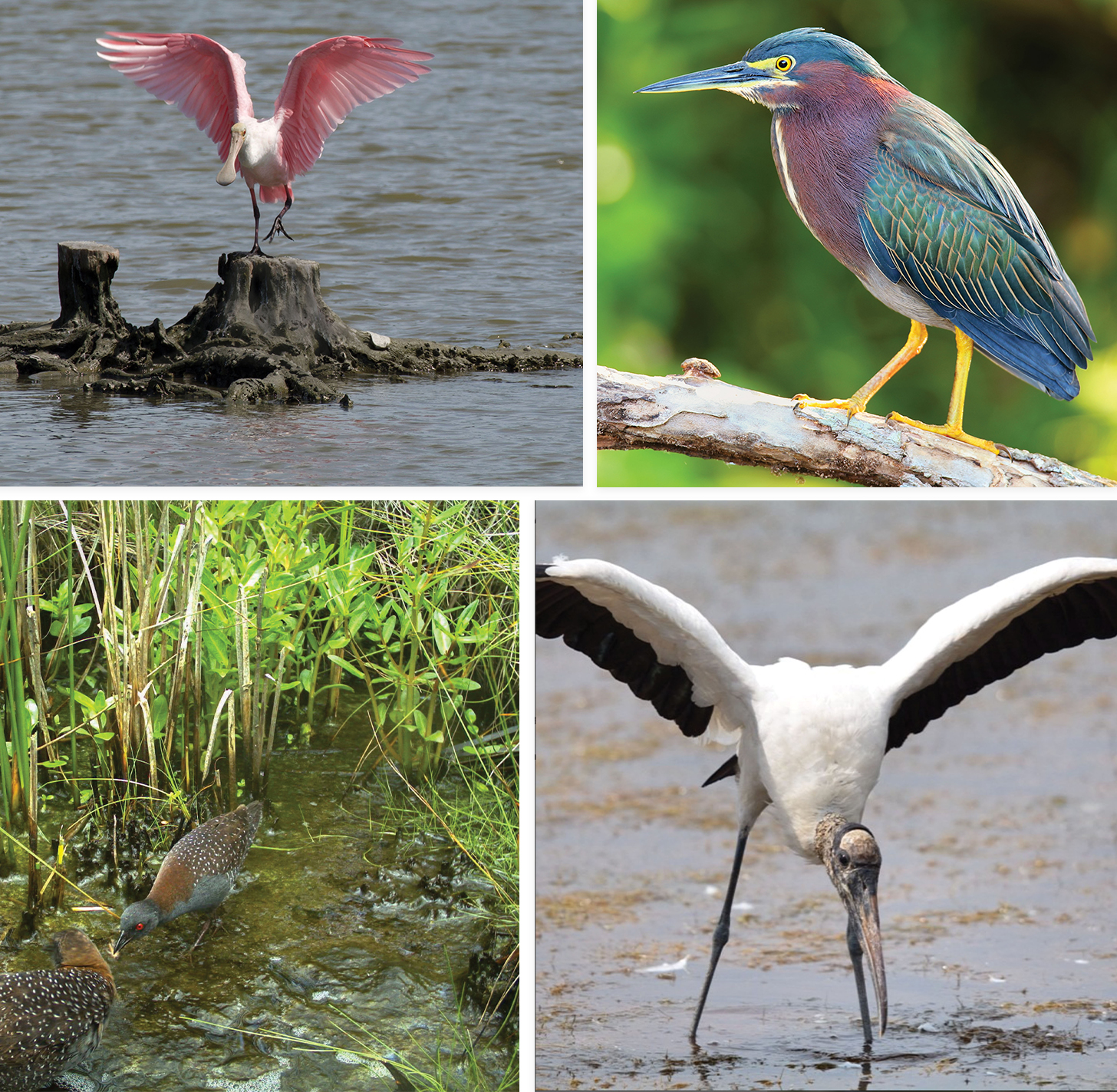
(Clockwise from top left) The Lowcountry has seen more roseate spoonbills in recent years, with the first nest recorded in 2020. ‘‘We’re just beginning with our spoonbill story,” says DNR wading bird expert Christy Hand; The green heron uses tools to lure prey; Wood storks are a rare success story; The black rail keeps a low profile by blending into dense marshlands.
The Lowcountry is blessed with a unique variety of marshlands
Some of the most promising avian news in the Lowcountry is coming out of wetland habitats where the likes of egrets, storks, and spoonbills forage and nest. These marsh dwellers, especially the showier sort—we’re looking at you, great blue heron—are often “spark birds” because of their accessibility. “Wading birds can be a great way to get started with birding, and they are widespread in the Lowcountry,” explains Christy Hand, the DNR’s wading bird project coordinator. “We have 14 different species, and they often nest and feed together.”
Perhaps the most obvious success story is that of the wood stork. Once a federally endangered species—largely due to habitat loss in their primary breeding grounds of the Florida Everglades, where the rainfall the birds rely on has become less consistent—the stork was reclassified as “threatened” in 2015, and its numbers have continued to climb thanks in part to a shift northward. Because the tactile forager relies on a variety of wetlands for feeding and nesting, the Lowcountry fit the bill quite nicely. The main draw: the vast number of impoundments built by enslaved people in the 18th and 19th centuries to grow rice. Today, many historic rice fields have evolved into a means of wildlife conservation, with water levels managed by the government or private landowners. For instance, a public and private partnership known as the ACE Basin Task Force Project created in 1988 has protected impoundments on 128,000 acres of land in the ACE Basin from the sort of development found on much of the state’s coastline. The transformation of these tracts from painful past to hopeful future isn’t lost on Lanham. “It’s where the whole conversation surrounding bird conservation and culture collide in the South Carolina Lowcountry,” he says.
Thanks in part to these efforts, the storks have proliferated since the DNR first discovered a nest here in 1981. Last year, the number of nests hit nearly 4,000. “We thought 2,000 was good,” says Hand. “They’re often able to raise more chicks than they have in other areas. They found a way to expand to areas where they could do better.”
Changing habitat in Florida is driving some waders north
Wood stork
Mycteria americana
Status: Low concern
After being listed as federally endangered in the 1980s due to habitat loss in Florida, the tactile forager is finding a foothold in the wetlands of the Lowcountry. At more than three-feet tall, the stork towers above other waders. Look for them in and around the ACE Basin National Wildlife Refuge.
Roseate spoonbill
Platalea ajaja
Status: Low concern
With its Barbie-pink plumage, balding pate, and trademark spoon-shaped bill, this flamboyant wader is unmistakable. The species has become more widespread in the Lowcountry, and biologists recorded the first nest here in 2020. Look for them in area marshland in the late summer and early fall.
Follow The Colorful Life Of The Roseate Spoonbill
Green heron
Butorides virescens
Status: Declining
Unlike its statuesque cousins, the stocky green heron keeps a low profile. It’s one of the few bird species that use tools, such as feathers or insects, to lure prey. Find them year-round on the edges of wetlands.
Black rail
Laterallus jamaicensis
Status: Declining/federally endangered
This nocturnal recluse has declined by 90 percent along the Atlantic coast, but persists in South Carolina because of our varied wetlands. But don’t expect to catch a glimpse of one; rather, listen for the male’s call near shallow marshland on spring nights.